September 16th was certainly a busy day in London, but then most are. I could have stood all day in queues waiting to visit some of the more interesting of the city’s buildings, as it was Open House Weekend, a two day event when many buildings open their doors to the public. It’s a great idea which came from Europe, beginning in France in 1983 and starting in London in 1992, and over the years I’ve visited quite a few places either generally closed to the public or which normally charge an entrance fee.
In the early years you just turned up and queues were generally non-existent or short, but the event has grown tremendously in popularity, and advance booking is needed for many of the more interesting sites and there are very long queues for some of the others, sometimes taking several hours. So I’ve largely stopped bothering.
I’ve never had a great interest in photographing interiors, and of course although this is an opportunity to take photographs (hard to stop anyway now that almost everyone has a camera on the phone in their pockets), permission to take photographs gives you no right to make any commercial use of them, though generally it would not be a problem to put them on non-commercial blogs such as this which generate no income (*though I’m always pleased to accept donations!)
I hadn’t intended to visit the Banqueting House on Whitehall, but was walking past it and noticed it was open and there was no queue. So when I found the protest I had come to photograph opposite Downing St was not there. I turned around and came back.
It’s a fine building, Palladio via Inigo Jones, built in 1619-22, the earliest neo-classical building in England. It provided a useful ascent to the scaffold for the only English monarch to get the end he deserved, the son of the man who commanded it to be built. King Charles I stepped out of a side window to be beheaded outside it in 1649. The interior is almost entirely a single large room, used for grand official events over the years, and would be rather plain except for its ceiling. Charles obviously thought so, and commissioned Peter Paul Rubens to paint it. Rubens did it in pieces in his Antwerp studio and they were shipped to London and installed. It is a very high ceiling, and to save visitors getting a crick in the neck there a several large mirror-topped cabinets in the room where you can look down and see up.
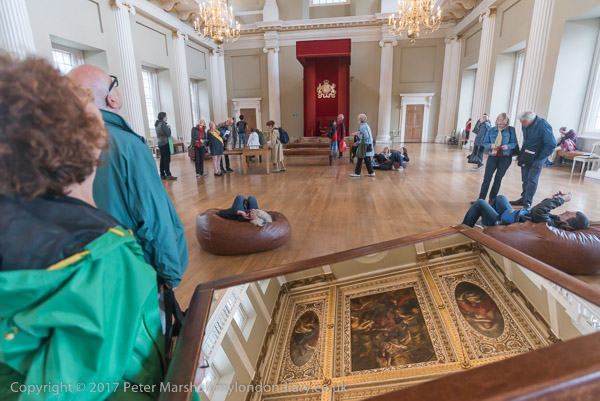
Alternatively there are cushions so you can lie on your back and contemplate it at your leisure, but I was rather afraid I might not be able to get up from these. I’m not a particular fan of Rubens, but the ceiling is certainly impressive.
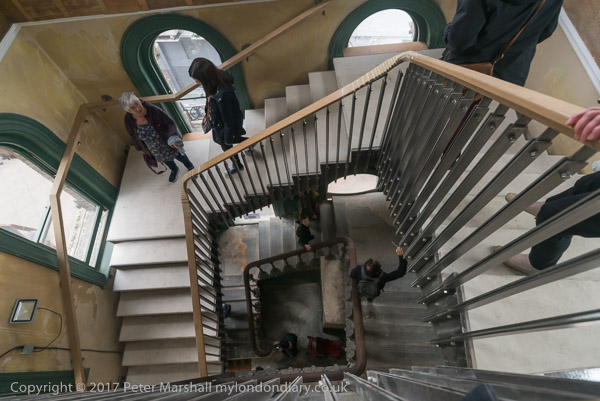
The building I had been intending to visit was the Old Waiting Room at platform level at Peckham Rye Station, reached by the impressive stairs in the picture, though my interest was perhaps more in the exhibition of local photographs that was taking place there. As someone who photographed Peckham in the 1980s and have seen the changes since I was interested to see more earlier pictures of the place. The show also included some more recent pictures, though I found these a little disappointing. There was another show of recent local pictures on a wall a little way down Rye Lane that was rather more lively that I also wanted to see, as well as going to Copeland Park, where other Peckham festival events were taking place, but I was too early for there to be much of interest happening.
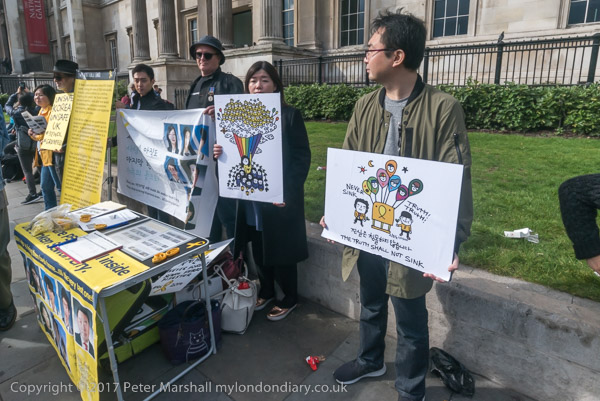
Back in the centre of London at Trafalgar Square I took a few pictures of the monthly protest about the Sewol ferry disaster. It was the 41st such event calling on the South Korean government to conduct a thorough inquiry into the disaster, recover all missing victims, punish those responsible and enact special anti-disaster regulations.
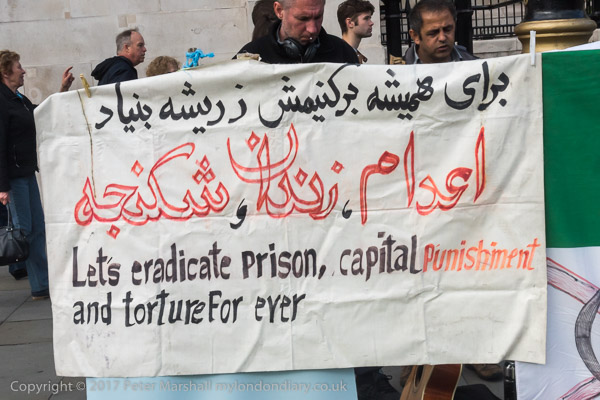
A few yards away, the 8 march women’s organisation (Iran-Afghanistan) were starting their protest on the 29th anniversary of the massacre of political prisoners in Iraq in which over 30,000 political prisoners, mostly members of the main opposition People’s Mojahedin Organization of Iran(PMOI/MEK) were executed.
Repression of course continues in Iran, led by a fundamentalist Islamic regime, and there were around 500 executions in 2017 and many trade unionists and human rights activists are imprisoned, with torture being used on a large scale to extract confessions which are used if they are brought to trial. Various religious groups are also subject to particular persecution, as too are the Ahwazi Arabs whose land in the Khuzestan Province in southern Iran is rich in natural resouces, and where Iran has long pursued a process of ‘Persianisation’, beginning with the rise of the Pahlavi regime in the 1920s attempting to eliminate the Ahwazi language and culture and take over the region.
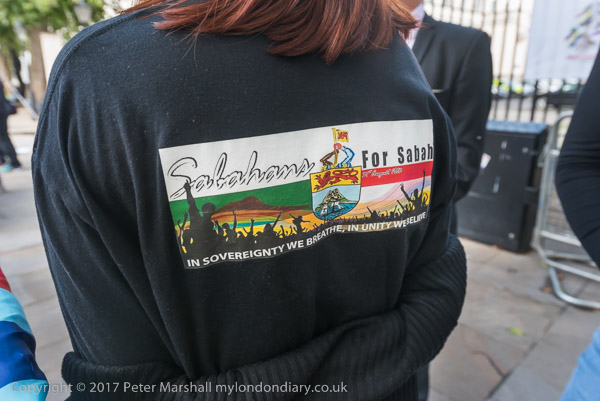
A short walk away opposite Downing St, a Malaysia Day protest was taking place by Sabahans and Sarawkians. They say Malaysia Day is a ‘Black Day for Sabah and Sarawak‘ and they call for a restoration of human rights and the repeal of the Sedition Act and and freedom for Sarawak and Sabah, the main areas of what Malaysia calls East Malaysia.
These two former British colonies on Borneo became part of the new Federation of Malaysia in 1963 with considerable autonomy, but this was greatly reduced ten years later. They argue that they entered the federation with equal status to Malaya but are now treated as simply constituent states on the same level as the states of Malaya, and there is a strong nationalist movement for secession.
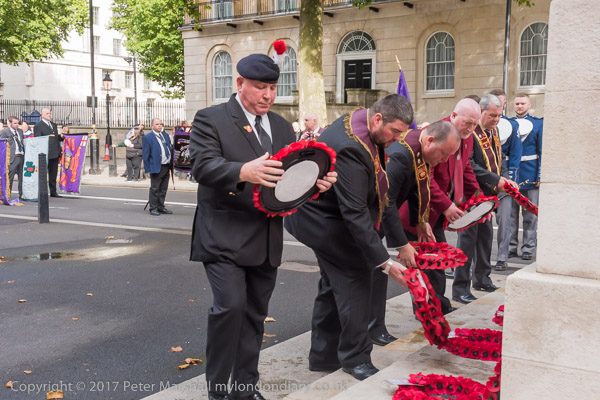
Finally I had been watching out for the annual Lord Carson Memorial Parade by lodges of the Orange Order including the various lodges dedicated to the Apprentice Boys of Derry and others remembering the Ulster regiments that fought on the Somme. I knew where they were meeting, but had decided not to go there as on some previous occasions I have been threatened when photographing their parades (though I don’t know why they should resent my reports, and others taking part have congratulated me), so was waiting for them on Whitehall, where I knew they would be coming to lay wreaths.
I’m not a supporter of the Orange Order, but I’ve always tried to report objectively on their activities in London. In my reports I have sometimes given some information about the past which they perhaps find uncomfortable – as for instance on this occasion where I state that Lord Carson, one of the founders of a unionist militia that became the Ulster Volunteer Force, later warned Unionists not to alienate Catholics in the north of Ireland – which parades such as this through some Catholic areas clearly do – though in London they are considerably less controversial.
Open House – Banqueting House
Open House & more – Peckham
41st monthly Sewol ‘Stay Put!’ vigil
Overthrow the Islamic Regime of Iran
Black Day for Sabah & Sarawak
Lord Carson Memorial Parade
______________________________________________________
*There are no adverts on this site and it receives no sponsorship, and I like to keep it that way. But it does take a considerable amount of my time and thought, and if you enjoy reading it, a small donation – perhaps the cost of a beer – would be appreciated.
My London Diary : Buildings of London : River Lea/Lee Valley : London’s Industrial Heritage
All photographs on this and my other sites, unless otherwise stated, are taken by and copyright of Peter Marshall, and are available for reproduction or can be bought as prints.
To order prints or reproduce images
________________________________________________________